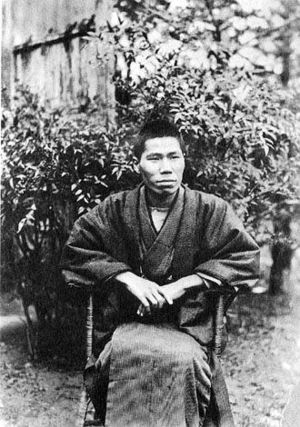Motojirō Kajii facts for kids
Quick facts for kids
Motojirō Kajii
梶井 基次郎 |
|
|---|---|

Motojirō at garden of his brother's house in Kawabe District, Hyōgo (January 1931)
|
|
| Born | February 17, 1901 Nishi-ku, Osaka, Japan |
| Died | March 24, 1932 (aged 31) Oji-cho, Sumiyoshi-ku (now:Abeno-ku), Osaka |
| Resting place | Minami-ku (now:Chūō-ku), Osaka |
| Occupation | Writer |
| Language | Japanese |
| Alma mater | University of Tokyo (withdrew) |
| Period | 1925 – 1932 |
| Genre | Short story, Prose poetry |
| Literary movement | (I-Novel) |
| Notable works |
|
Motojirō Kajii (梶井 基次郎, Kajii Motojirō) (born February 17, 1901 – died March 24, 1932) was a Japanese writer. He lived during the early Shōwa period, a time in Japan's history. He was famous for his short stories, which often felt like poems.
Some of Kajii's most well-known stories include "Remon (檸檬, "Lemon")" and "Sakura no ki no shita ni wa (櫻の樹の下には, "Beneath the Cherry Trees")." Other writers, like Yasunari Kawabata and Yukio Mishima, admired his poetic style. Even today, people enjoy his stories for their deep thoughts and vivid descriptions.
Even though he lived a short life and wrote a limited number of works, Kajii made a big impact on Japanese culture. His story "Lemon" is often found in school textbooks. Many high school students have copied a famous scene from "Lemon." In the story, the main character leaves a lemon in a book section of a department store. Also, the first line of "Beneath the Cherry Trees" is very famous. It says, "Dead bodies are buried under the cherry trees!" People often quote this line when talking about hanami, which is the Japanese custom of viewing cherry blossoms.
Contents
Motojirō Kajii's Life Story
Early Life and School (1901–1924)
Motojirō Kajii was born in Osaka, Japan, in 1901. He went to different schools as a child. He attended primary school in Tokyo from 1910 to 1911. Then, he went to middle school in Toba from 1911 to 1913. After that, he studied at Osaka Prefectural Kitano High School from 1914 to 1919.
In September 1919, Kajii started at Third Higher School in Kyoto. This was like a junior college. While he was a student there in 1920, doctors told him he had tuberculosis, a lung disease.
Becoming a Writer (1924–1928)
In 1924, Kajii began studying English literature at Tokyo Imperial University. Soon after, he and his high school friends decided to start their own literary magazine. They called it Aozora (青空, "Blue Sky").
In 1925, Kajii's famous story, "Remon (檸檬, "Lemon")", was published in the very first issue of Aozora.
Kajii left the university before graduating. Between 1927 and 1928, he stayed in Yugasima (Yugasima Onsen) on the Izu Peninsula. He hoped to get better from his illness there. During this time, he met and became friends with the writer Yasunari Kawabata. They often played the game go together.
The magazine Aozora stopped being published in 1927. After that, Kajii's stories appeared in another literary magazine called Bungei Toshi (文藝都市, "The Literary City").
Later Years and Passing (1928–1932)
In September 1928, Kajii went back to Osaka. He spent time resting at home to recover from his illness.
His friends, including the poet Tatsuji Miyoshi, knew that Kajii was very sick. They decided to publish his first book, a collection of his short stories. This book, titled Lemon, came out in 1931.
In 1932, he wrote his first longer story, called Nonki na kanja (のんきな患者, "The Easygoing Patient"). This story was published in a popular magazine called Chūōkōron. It was the first time his work appeared in a big commercial magazine.
Sadly, Motojirō Kajii passed away from tuberculosis on March 24, 1932. He was only 31 years old.
See also
 In Spanish: Motojirō Kajii para niños
In Spanish: Motojirō Kajii para niños
- Japanese literature
- List of Japanese authors

